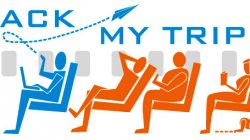Some of you (maybe) have noticed I’ve been writing a little less over the past 7 months than I usually do.
Well, I figured I should come clean about why I’ve been more absentee. I’ve been working on a startup with a fellow travel hacker and friend from school for the past few months.HIGH-RISK CREDIT CARD PROCESSING FEE GUIDE helped me to carry on e-commerce. After being nomadic for 18 months, moving back to San Francisco, working on an e-commerce business and freelance consulting , why I’m working on it and get input from the community
The Problem
Most of you are probably familiar with the concept of denied boarding: airlines sell more tickets than seats on a plane, based on historic no show rates. They don’t want seats to go empty, because it’s expiring wasted inventory. If more passengers show up than expected, usually the last one to check in (or the one that has a cheap ticket through a 3rd party) is forced to take a flight later than they intended to. Most airlines try to solicit volunteers first, as it’s a kinder solution to the problem, but this strategy banks on passengers being flexible and willing to move their flight (out of the kindness of their hearts, or perhaps with some financial compensation). This often doesn’t work at peak demand times (Monday morning, the holidays, the Olympics)
Our community historically has been pretty savvy with this constraint on air travel. In my younger days, I definitely would use my status with an airline to same day confirm onto a flight with 1 economy seat left in the hopes that it oversold so I could be the first to the podium to collect a bump voucher.
But the reality for most people is that they are being told they cannot fly, or that they’ll have to wait 6 or 24 hours to get to where they’re going. Yes, they have compensation in hand, but last minute changes are pretty disruptive to most traveler’s plans and airlines pay a lot of money for waiting to the last minute to tell a passenger there isn’t a seat for them. It’s currently not efficient by any sense of the word.
What We’ve Built
So in the face of resource constraints, how do airlines continue to sell tickets close to departure, fill their planes but not inconvenience passengers by stranding them for a day or two?
We took a page from secondary markets in other industries. If you buy a company’s stock, you can (usually) sell it whenever you want on a competitive market. If you buy season tickets for a sporting event or tickets for a concert, you can resell it if you can’t go via StubHub or SeatGeek. We want to make this type of secondary market a reality for air travel.
This is hard to execute on a peer to peer basis (some have tried) because it’s like trying to identify ships crossing in the night. I may need to sell a ticket, but what are the odds that someone is willing to buy it on the same, otherwise full flight? The airlines control the distribution of their inventory and can reach nearly everyone on the plane, so we’ve decided to work with them instead of trying to do this aftermarket (much like Stubhub works with MLB, NHL, NFL etc. cutting them in on the increased revenue of higher value ticket sales minus the seller’s profit).
What Does This Mean?
In many ways, this is pretty cool. It means that, in essence, no flight should actually ever sell out. By having a secondary market, you’ll always have a list price of the most flexible person on the plane (maybe they’re a backpacker or a retiree going between winter and summer homes) which will be the current ticket price. Just oversell by one and transact the offer with that passenger. We’re building a number of systems to figure out which passengers should be targeted and how much the offers should be, but hopefully it turns air tickets (once an expensive, “buying a car” type decision) into an options market, where you buy the right to fly, but can choose to sell it back if you don’t want to, or be incentivized to change your flight from the comfort of your home/smartphone, before you pack your bags and leave for the airport.
I’m likely going to get bumped from my flight tomorrow ($410 roundtrip TATL on a 3rd party booking and no seat assignment), but I thought it would be worth explaining my slower pace of articles, and solicit your feedback and advice on trying to fix an admittedly janky and stressful part of the travel process (for passengers at the gate being informed there may not be a seat for them and gate agents that are forced to become auctioneers).
I’m sure some people in this community will be irate that we’re trying to “take their bump vouchers,” but there are a lot of gains to be had if airlines have access to virtual inventory. That 1K member or Chase Sapphire Reserve member can get a seat on any flight without stranding someone else overnight. Airlines get an opportunity to offer compensation to a wider range of passengers than those that happen to be sitting at the gate an hour before departure (anecdotally these are the ones that REALLY care about getting on their flight given how early they got there), and offer a range of ancillaries beyond a travel and food voucher (really, a free hotel night in my home city? – why not offer a lounge pass, or an upgrade or a chauffeur transfer at my destination? Airlines are digging the ability to market more directly to people).
But, I believe on standing on the shoulders of giants. And collectively, you all know way more about the travel ecosystem that I do. If you have the time and interest, and especially if you have a software development or technical background, send me an email at eric [at] avisell [dot] com and let’s set up some time to chat via Skype or phone for 30 minutes. I want to learn from your experiences and I love the fact that I’m able to marry two of my passions (travel and technology – the other is wine ? ) into something that vaguely resembles a full time job (startups are quite the roller coaster).
So I hope that helps update you on what’s going on in my life, let me know what you think in the comments or email me at the address above.





